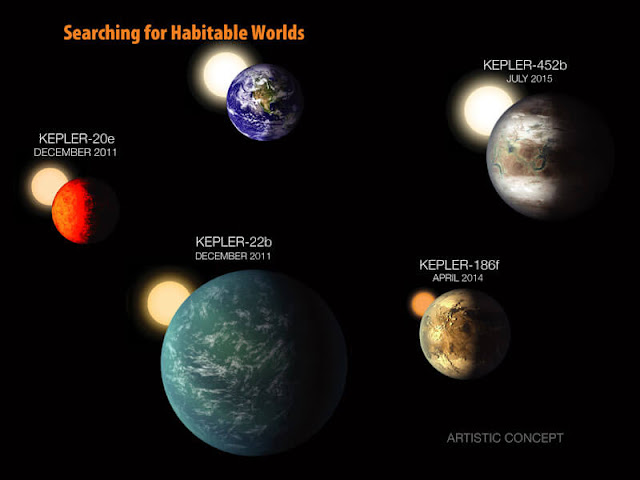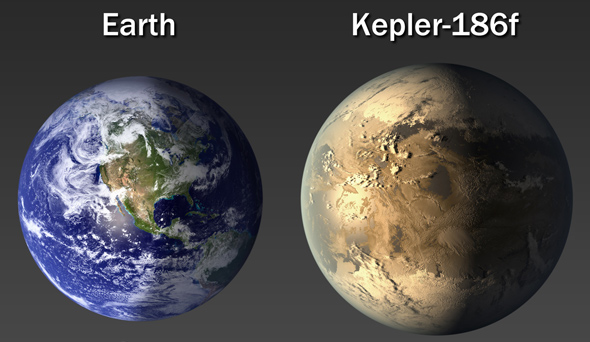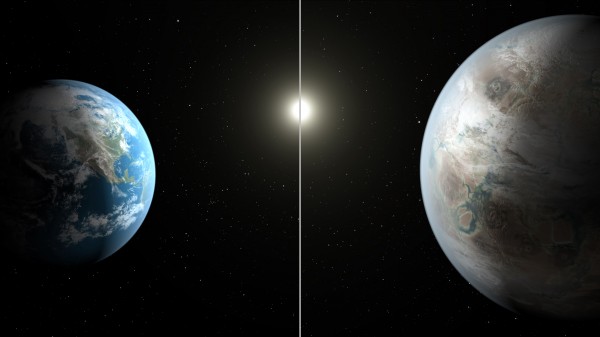 |
| Credits: NASA Ames/W. Stenzel |
Kepler-186f
This planet is named Kepler-186f and it is one of five planets that have thus far been detected by NASA’s Kepler space telescope in orbit about the star Kepler-186. This star is smaller and cooler than the Sun, of a type called an M-dwarf or red dwarf, and all its known planets are small as well, with sizes less than 1.5 times the size of Earth. The planet Kepler-186f is the smallest, being within 10% of the size of Earth and orbits furthest from the host star, within the habitable zone. This is the region around a star within which a planet can sustain liquid water on its surface given the right atmospheric conditions. The Kepler-186 planetary system lies in the direction of the constellation Cygnus, about 500 light-years away.
HD 904790
The space agency’s researchers told the media that the recently identified planet, HD 904790 b, wipes the floor with Earth in every possible way, pointing to the celestial body’s larger size, unblemished terrestrial surface, diverse and verdant landforms, and abundance of natural resources, all of which indicate that Earth is a festering pile of garbage in comparison.
“This is a thrilling and scientifically vital discovery that has substantially furthered our understanding of how much Earth truly sucks,” said lead researcher Lisa Shapiro, emphasizing that Earth appears to be “straight-up dogshit” when contrasted with HD 904790 b’s exceptional terrain and climate. “Just taking into account this new planet’s flawless spherical shape, not to mention its pristine atmosphere free of methane and other toxic gases, reveals that our home world is pretty fucking pathetic when it comes down to it.”
“HD 904790 b has an extensive ring system that dwarfs Saturn’s, zero tectonic plate activity, and more fresh water in just one of its massive, unpolluted oceans than we have on our entire worthless shitstain of a planet,” she continued. “God, it makes me angry just to think of how much nicer it is there.”
[Read More: Click Here]
Kepler-452b
This week (July 23, 2015) at a NASA teleconference, scientists with the
planet-finding Kepler mission took a step closer to that dream with the
discovery of the first nearly Earth-sized planet orbiting in the
habitable zone – or zone where liquid water can exist – of its sunlike
star. The planet is located 1,400 light-years away, in direction our
constellation Cygnus the Swan. It has many similarities – and also some
differences – to the world on which we stand.
The first near-Earth-size planet is called Kepler-452b. It’s the smallest planet to date discovered orbiting in the habitable zone of its star. Considered a super-Earth-size planet, it’s 60 percent larger in diameter than our world. Its orbit around the sun last 385 days, only 5 percent longer than Earth’s orbit. It’s star is a G2-type, like our sun. Kepler-452b is 5 percent farther from its parent star than Earth is from our sun.
The first near-Earth-size planet is called Kepler-452b. It’s the smallest planet to date discovered orbiting in the habitable zone of its star. Considered a super-Earth-size planet, it’s 60 percent larger in diameter than our world. Its orbit around the sun last 385 days, only 5 percent longer than Earth’s orbit. It’s star is a G2-type, like our sun. Kepler-452b is 5 percent farther from its parent star than Earth is from our sun.









One technique commonly used by planet hunters is called the radial velocity, or Doppler, method. How does it work??
ReplyDeleteIt notes wobbles in a star's motion caused by the tugs of orbiting planets
DeleteWhy did the discovery of planet Kepler-16b make big news in September 2011?
DeleteIt's the first confirmed exoplanet with two suns in its sky
DeleteIt's the first confirmed exoplanet with two suns in its sky
ReplyDeleteCharlie technogly is everywhere scientist are very well educated and are find ad fix of eart problems besides it worth it in he end what isit turns out good
ReplyDeleteDo u even know what 500light years means. It means that the distance from Earth to Kepler is 500×9646billion km. While the distance from Earth to Moon is only 380000km. Which means that it will millions of years to land on Kepler. So dont be a fool and say we can land on this planet as we landed on Moon.
DeleteIn theory it could be accomplished in approximately 10,700 years ish.
DeleteActually, using powerful electromagnetic forces, one could contract spacetime in front of a spaceship, and expand it behind the vehicle. This would create a spacetime "wave" wherein one could travel faster than the speed of light relative to an outside observer. The tech and science behind this theory is still in its infancy, but conservative estimates suggest that we will have that capability in the next 140 years. If we don't kill each other off first, anyway.
DeleteRed Dwarf Stars have a longer life than our star... If the planet is in the habital zone with an actual rotation, water, and strong atmosphere along with many other necessities it's an amazing find. Now... Getting there is an issue and acclamation to the environment is also a problem. We have no tolerance for its microbes.
ReplyDeleteassuming the planet is indeed habitable and has a thick atmosphere there's a chance at life on it though i doubt there would be any intelligent life but if there is i would like to see how there technology is different to ours though even if there was i wouldn't get the chance to see at least not in my life time xD
ReplyDelete